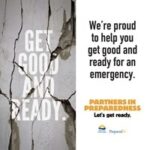Friday Roundup – Sports, Drills and the Cloud
On a rather soggy Friday morning, I sit at my keyboard to update you on this past weeks comings and goings in the emergency preparedness world. Three morsels for you to chew on today. The first on sports facilities, the second on tests and drill and finally we wrap with our heads in the Cloud.
If you were at home or the office, if preparations have been made, your world is relatively ready. However, what if you are at a place where thousands of others are gathered, it is enclosed and the entrances and exits are fine for an orderly exit, but not a mass one. Our first article speaks to emergency preparedness at sports facilities. This downloadable PDF covers in basic lists the responsibilities of all the facility personnel. From the Facility Manager who has to coordinate and provide leadership to the Facility Food Personnel who need to have sufficient food and water in the event of a disaster. It goes on to detail Preparing the Disaster Plan to make sure everything that can be done is done in event of a catastrophe. Good advice.
Speaking of making plans and making sure personnel are well versed in their roles, I am posting several links to emergency planning tests and drills that local councils are making in their area. What I like about these initiatives is that after the various natural disaster seasons have calmed down, area emergency managers want to ensure they are ready. The one from NPTelegraph.com speaks to how to handle an outbreak of foot-and-mouth disease in rural Nebraska.
The Cloud. Depending on which generation you are born into, this conjures up different meanings. Doing a quick google search brings the realization that “The Cloud” has nothing to do with nature but all to do with computing.
Sigh!
Our final article today is titled “10 Disaster Preparedness Questions to Ask Your Cloud Services Providers”. It covers a lot of computer jargon but the bottom line for Emergency Management people and their IT department, is how do we stay online and reduce or eliminate downtime during a natural disaster. Your business life depends on it.
Until next week… Keep Calm and Carry On.








